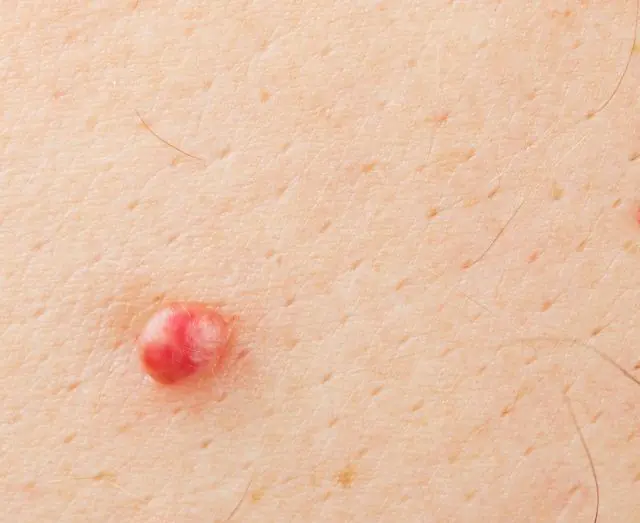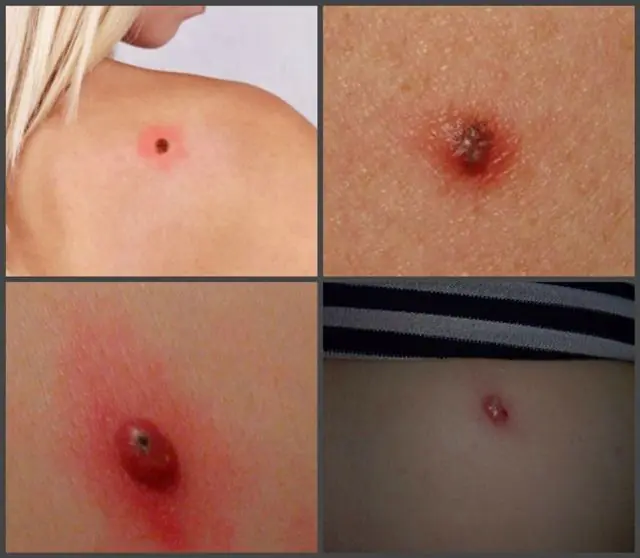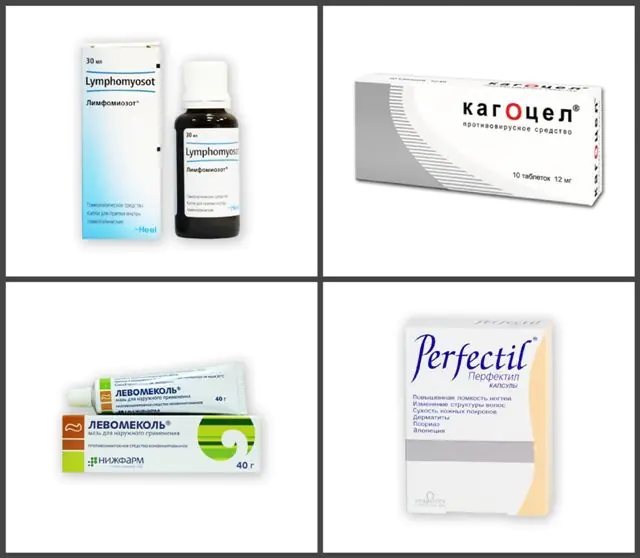
- Why does the papilloma turn red?
- What to do
- Folk remedies
- Medicines
Redness of papilloma is a pathological process, which is based on changes in its natural, most often beige or pale pink color. In a normal situation this does not happen; there are always some reasons that cause such deviations. They can be both external and internal, or combined in the same person.
Why does the papilloma turn red?

The photo shows reddened papillomas
One of the main reasons that the papilloma turns red is the activation of the virus that caused the formation. Absolutely anyone can face this, regardless of age, but most often the elderly, children and pregnant women suffer from this problem. This is easily explained by the deterioration of their immunity, which is why the body is unable to fight HPV.
Among the factors contributing to the redness of papilloma are the following:
- Exposure to UV rays. If you sunbathe occasionally or stay under the sun in closed clothes, then the likelihood of the formation changing color becomes minimal. But it increases sharply when staying on the beach or just outside from 12 to 16 hours, when ultraviolet radiation is most dangerous for human skin.
- Injury to the growth. Visually, the papilloma can maintain its integrity, but upon closer examination, minor damage can be detected. Infections, penetrating through them, contribute to the appearance of redness. Impacts, friction on clothing, constant contact with chemical reagents contribute to their occurrence; all this also contributes to the redness of the papilloma.
- Pregnancy. The reason for the change in the color of the formation during the period of bearing a child is most often a decrease in immunity, which is observed in the majority of expectant mothers. This phenomenon causes a lack of useful substances in the form of vitamins, micro- and macroelements, which, when entering the body, are now also spent on the baby.
- Hormonal imbalances. First of all, the redness of papilloma concerns adolescents whose menstrual cycle is just stabilizing. This reason is also worth paying attention to for women facing menopause and those who are about to experience it in the near future. The reason for the color change in the growth may be disturbances in the production of hormones by the thyroid gland, kidneys, or ovaries. Hyperemia is provoked by both their excess and deficiency.
- Long-term stress. Severe emotional exhaustion weakens the immune system and prevents the body from normal resistance to the papilloma virus. This is most often the catalyst for redness of the papilloma. It can also be triggered by chronic lack of sleep, frequent conflict situations at work and in the family, and increased mental stress.
- Malignancy. This is the name for the process of degeneration of educational cells into malignant ones. At this stage, there is still no basis for making a diagnosis of oncology, but there are already prerequisites for this. As a result of such changes, the growth may also increase in size.
Of particular danger are various care products, containing a large number of synthetic components such as parabens, dyes, fragrances and other harmful substances. All this often causes skin irritation, which quite often entails hyperemia of the formation.
Among other causes of reddening of papilloma, it is necessary to highlight failure to comply with personal hygiene rules, which can lead to the penetration of various pathogenic microorganisms, which cause hyperemia of the formation.
- Read also why papilloma becomes inflamed
What to do if the papilloma turns red?
First of all, you need to contact a dermatologist so that he can assess the condition of the growth on the body and rule out its malignancy. You may need to perform a biopsy, which can detect cancer cells with almost 100% certainty. It is also worth consulting a virologist and immunologist.
Folk remedies for the treatment of redness of papilloma

Regardless of why the papilloma turns red, a compress in the form of a piece of gauze dipped in chamomile infusion helps a lot. You can prepare it from warm water (1 l) and dried herbs (300 g). The lotion should be kept on the formation for about 20 minutes, the optimal number of such procedures per day is 2 times.
Here's what you can do if the papilloma turns red:
- Boil water (2 l), add crushed pine branches (2 tbsp), add elderberry rhizome (1 tbsp) and nettle (1 tsp). Cover the product with a lid and leave for 2-3 hours. Then filter it and pour it into the half-bath. Take it for half an hour, or until the water cools down. Treatment should last at least a week.
- Grind the powdered sulfur with honey, take 50 g of the first component, and 200 ml of the second. Stir the mixture well; if necessary, beat it with a blender. Apply this product to the growth, leaving it on for 15 minutes, 2-3 times a day. The optimal duration of treatment to eliminate redness of papilloma under the armpit or on other parts of the body is about a week.
- Steam the sprouted oats by pouring (5 tablespoons) boiled water (100 ml). Leave the mixture covered for a day, and in the morning, drain the liquid and use it to wipe papilloma on the body 2-3 times a day. Carry out this treatment for a week.
- Aloe juice helps a lot because it has excellent anti-inflammatory and soothing properties. To obtain such effects, wipe the reddened formations with it 2-3 times a day for 2 weeks. You can also simply apply a leaf of this plant to them, keeping it there for about 30 minutes under a bandage. It is also recommended to make compresses from aloe juice and a cotton swab or a piece of gauze, which can be left on the reddened papilloma for about 20 minutes.
- Chop plantain leaves to make 3 tbsp. l. mush. Then chop the nettle; you need to take 1 tsp of this component. Next, combine them and add lemon balm (2 tsp), and then add dandelion flowers (100 g). Pour boiling water (1.5 l) over all this and keep on low heat for about 30 minutes. After this, strain the mixture and take the resulting liquid 50 ml every morning. Carry out this treatment for 1-2 weeks.
- Grind calamus roots (2 tsp), St. John's wort (1 tsp), plantain (2 leaves). Combine these components with dill and clover seeds, taking them in equal proportions, 1 tsp each. Then pour boiled water (2 liters) into this composition and keep it on the stove for about 20 minutes. Next, simply filter the mixture and, to eliminate the redness of the papilloma, drink the remaining liquid 50 ml once a day for breakfast.
- See also what to do if the papilloma itches
Medicines to eliminate redness of papilloma

In the photo there are medications for redness of papilloma
Since most often the papilloma turns red as a result of infection of the formation, the first thing you need to do is start treat it with antiseptic solutions. For these purposes, you can use ethyl, salicylic or formic alcohol. You may also need products such as Miramistin, Betadine, Chlorhexidine. Don’t forget about ordinary iodine, brilliant green, hydrogen peroxide, the cost of which most often does not exceed 100 rubles.
When the papilloma becomes red, it is recommended to use the following drugs and remedies:
- Vitamins. They are needed to prevent the deterioration of immunity and to successfully recover from hyperemia. The Vitrum Beauty complex is very effective, the cost of which is about 500 rubles. (220 UAH). It has wonderful analogues - “Duovit”, “Doppelgerts Aktiv”, “Perfectil”. On average, you need to take these drugs for 2-4 weeks, but it is better to complete the full course. Even if the redness is successfully eliminated, it is recommended to repeat it after six months.
- Immunomodulators. From natural preparations created on the basis of plant components of ecological origin, you can buy Lymphomyosot to eliminate the redness of papilloma. On average it sells for 450 rubles. (210 UAH), produced in the form of drops. Echinacea purpurea is also produced in the same form, which is also considered very effective. Among the syrups, Immunal and Immuno-Ton stand out. If you need to increase your immunity level in a short time, then you should pay attention to the injection solution “Antirabies Immunoglobulin”.
- Antiviral. They are needed to eliminate tissue swelling, which is directly related to the redness of the papilloma. Here we can recommend a good drug “Likopid” costing 600 rubles. (250 UAH). It can be adequately replaced by Cycloferon or Kagocel tablets, which should be taken for 4 days in a row. This treatment will suppress the activity of the virus and speed up recovery from hyperemia.
- Anti-inflammatory. We are mainly talking about external remedies, for example, Solcoseryl ointment helps a lot, its cost is 300 rubles. The product should be applied to the growth 2-3 times a day for at least a week. If necessary, it can be replaced with Panthenol, Levomekol, Aldara or Dermatix. All this should be used for 1-2 weeks, until the redness of the papilloma disappears. The composition should be applied in a thin layer 2-3 times a day and left until absorbed.
After overcoming the acute phase, you can think about removing the papilloma, since there is a possibility that it will redden again. For such purposes you can use Lapis pencil, Feresol, CryoFarmu, Condilin or Dermavit. All of these products are solutions that are applied pointwise using a cotton swab or a piece of gauze.
If it is not possible to eliminate the problem of redness of the papilloma for a long time, then the question may arise of removing the problematic neoplasm. There are several methods for this - cryodestruction, electrocoagulation, laser therapy or radio wave radiation. Each of them has its pros and cons, so only a doctor can help you find the appropriate method.What to do if papilloma becomes inflamed - watch the video:
Before you start doing anything, you need to have a good understanding of why the papilloma turned red. Only after all possible causes have been clarified should treatment begin, and these factors must first be eliminated. If hyperemia does not go away as a result of treatment for a long time, it means that the wrong methods were chosen. In this case, it is recommended to contact specialists for advice.
- Related article: what to do if you have injured a papilloma



